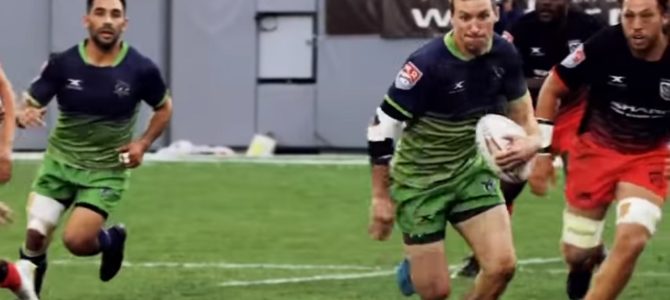
The inaugural season of Major League Rugby has just come to its conclusion, and I was there to witness the end from center field. On July 7, the Seattle Seawolves faced off against the Glendale Raptors at the University of San Diego’s beautiful Torero Stadium. It’s an intimate stadium designed as a multi-sport field.
While it seats 6,000, it appeared as if only about 3,000 were in attendance. But that 3,000 was pretty rowdy, especially the Seawolves fans. They dominated the stadium for most of the game.
Seattle was victorious. The final score was 23-19. It was a closely fought contest, and the teams seemed to be essentially evenly matched. The most notable difference between them was perhaps the presence of the rookie Vili Toluta’u. His massive hair makes him easy to spot on the field, and it seemed as if he was involved in almost every significant play throughout the game. His quality is undeniable, and he was recently promoted to the Eagles.
There is much to like about Major League Rugby (MLR), although this organization is a massive underdog in a very crowded commercial sports market. Sometimes from small things big things come. Sometimes not so much.
Professional Rugby Organization was the first attempt at a U.S. league, and it lasted less a than a year, closing in January 2017. If MLR is to stand any chance of survival, myriad factors are at play. The quality of the product is essential to the success of any sports league. As it stands, MLR’s quality of play is middling.
I love rugby. My international Christian high school in the Philippines hosted a 10-man form of Rugby Union. Only three other schools on the island of Luzon hosted similar programs, so our entire season consisted of six-round round robin tournament weekends with modified game length. It was a smashingly good time, with a wonderful communal relaxed atmosphere. I was never a very good player, but one of the best things about sports like rugby is that one person’s foibles don’t determine success.
So I love all versions of rugby but feel a lot of affection for this attempt at creating a foothold for rugby in America because of my “minority” experience in the Philippines. For a professional-level league, however, MLR lacks in overall quality. The play is generally very undisciplined and sloppy. This made for some exciting moments, but overall defense always benefits from a lack of mental toughness.
Tactically, Rugby Union is radically different from gridiron football. It’s kind of like running an exclusively option-based offense except there’s no blocking allowed and no “restarts” via downs and snaps. The option offense is almost universally shunned in the National Football League and increasingly unpopular in the National Collegiate Athletic Association because it severely hampers versatility. If blocking were illegal in gridiron football, then option-based offenses would be completely gone, because the whole idea is to create space on an outside angle forward.
The same fundamental principle is at play in rugby, except that the players are not seeking to advance five to ten yards with one lateral. Rather it’s supposed to be 20-30 yards on the back of 10-15 sequential laterals. This is one of the most complicated ballets in all of sports. To be a part of a string of rugby passes advancing the ball forward on the back of each tackled player is a truly exhilarating experience, whether playing or watching.
It’s almost like a miniaturization of the Pony Express. Precious cargo is in your hands, but you can’t get it to where it needs to go on your own. So you draw in as many tacklers as possible, then offload the ball at the last second. This means that you should now have more teammates in support for the next ball carrier than the opposition does for defense.
It’s simple math: get more runners in support of the ball than the other team has defenders. This is accomplished by running in support of the ball carrier to receive a pass, then passing to the next player and sprinting to get back into support. It’s truly amazing to behold when it works well, and a cardio workout unlike any other. If you don’t feel like you’re drowning, you probably aren’t playing hard enough.
Unfortunately, MLR has horrible passing. There seems to be a lack of attention to fundamentals. They’re also overly reliant on complex maneuvers like the Maul. The Maul maneuver is a very controversial rule in Rugby Union because it violates multiple principles of the game yet the tactic is officially legal. The Maul is a very bizarre part of Rugby Union and hard to explain but this video does a really good job of depicting it.
Mauls are relatively uncommon in rugby generally, but there were at least three formed over the course of the MLR championship. They have a tendency to bog down the game because they tend to tighten up play and draw in lots of players. They function much more like the offensive and defensive lines do in football than the normal advancement in rugby, because rugby is all about gaining on the gaps and getting to the edges of your opposition’s defense.
I’m not saying they aren’t useful. They can be when used cleverly, but they usually detract from the entertainment value. And entertainment value is what MLR desperately needs next season.
The best thing about the championship was the announcer. A fundamental gripe I’ve had for years with U.S. TV is they get sports announcers whom Americans don’t know are color commentators instead of educators. They think people will respond to the passion, but confusion completely dulls passion. This announcer did an excellent job of explaining what was happening.
MLR definitely has potential, but as it currently stands my hopes are not high. It’s certainly worth checking out next season if you’re curious, but it’s not going to be a premier sports destination anytime soon.









